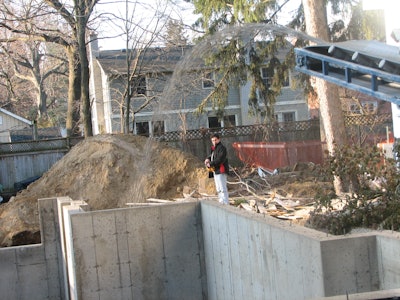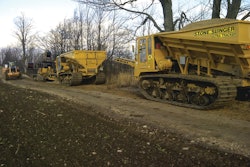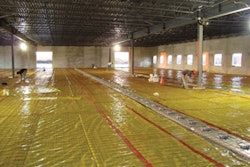
John Da Silva of Rock Concrete Forming Ltd. in Mississauga, Ontario, was seeking out a better way to place concrete materials on the jobsite. He found it in the form of the Stone Slinger truck conveyor with a Creep Drive system.
The Creep Drive system provides operators with a remote control feature that not only controls the speed and direction of the conveyor, but allows the operator to remotely maneuver the truck around the jobsite. The operator now has a single set of controls to run the conveyor and reposition the truck for ideal placement of the material, without returning to the truck.
According to Da Silva, the investment in the Creep Drive feature is paying off. “On a typical weeping tile job, the driver has to go back and forth to move the truck four or five times. And each time, when you get into the truck, you have to turn the PTO off, drive the truck, put the air brakes on again and restart the PTO. It’s the time savings that pays you back.”
By using the remote control to move the truck, the operator remains outside the cab to keep the material flowing until the load is completely delivered. Da Silva says that getting out of the truck is the right place for operators to be.
“You get out here and you can see everything," he points out. "We are always working in very tight spaces. You can watch the wheels and the ground more closely than if you’re steering from the cab. You won’t ever put the truck into a pothole or a ditch, so you never have to wait for another truck to come and pull you out.”
The Creep Drive adds a complete hydrostatic drive system to the standard powertrain of the truck. A hydraulic-driven gearbox is inserted into the driveline. A CAN Bus panel controls all hydraulic and operating functions and communicates with the remote, which the operator carries in a sling.
Safety was a key factor in the design of the Creep Drive. “The maximum speed the truck can achieve under hydraulic power is 1.6 mph (2.5 km/h) – a comfortable walking speed," explains Scott Nelson, manager of W.K. Dahms. "The control circuitry receives constant feedback on the actual wheel speed from the truck. If the truck’s on an incline, the hydraulics will brake its speed automatically. Several fail-safes are built in, as well. If the wheel speed exceeds 2.5 mph (4 km/h), the CAN Bus will shut down and stop the truck completely.”
Da Silva finds that the system leads to better job quality with less wasted material. Operators naturally tend to avoid extra walks back to the truck if they can. By making it easy to move the truck into the best location, Creep Drive helps operators to distribute the material more precisely and consistently with no extra time or inconvenience. For a contractor like Rock Concrete Forming Ltd., that translates into lower costs for clean-up and for material.


















